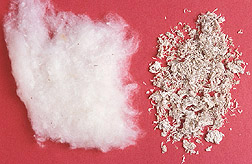Spinning Clay into Cotton
Adding clay to cotton fibers can keep cotton from readily bursting into flame when heated.
By Emily Sohn
You’re probably not allowed to wear your pajamas when you play in the dirt. Someday, though, the clothes you wear to bed may be made partly out of clay.
 |
|
Children’s sleepwear isn’t made from cotton because ordinary cotton can burst into flame when it’s heated. |
Before you go to bed tonight, read the label in your pajamas. Chances are, you’ll find that they’re not made of cotton. The problem is that cotton burns easily. Parents don’t want to dress their kids in pajamas that can catch fire.
But most people like to wear cotton clothes. Cotton is soft and feels good on your skin. Air flows through it easily, which helps keep you cool when the weather is warm.
Now, researchers from the Agricultural Research Service’s Southern Regional Research Center in New Orleans may have found a way to use clay to make cotton more resistant to heat.
The scientists dissolved tiny bits of cotton in a liquid and added microscopic particles of clay. Then, they spun fibers out of the solution that were 93 percent cotton and 7 percent clay.
 |
|
Untreated cotton (right) and a new form of cotton fiber containing 7 percent clay (left). |
| Peggy Greb/Agricultural Research Service, U.S. Department of Agriculture |
Tests in a special heat chamber showed that the clay-enhanced cotton was more resistant to heat than untreated cotton. When heated, the treated fibers formed a layer of char on their surfaces. In a fire, the char coating would keep oxygen out of the fibers. Without oxygen, flames can’t erupt.
The researchers are now starting to weave cloth from their clay-cotton fibers. They can then test the new material to see if it’s less flammable than ordinary cotton cloth.
Watch out. Clay-boosted pajamas may someday be headed to your slumber party!—E. Sohn
Going Deeper:
Goho, Alexandra. 2004. Flame-retardant cotton gets a boost from clay. Science News 165(April 17):253. Available at http://www.sciencenews.org/articles/20040417/note13.asp .
You can learn more about adding clay to cotton fibers at www.ars.usda.gov/is/pr/2004/040406.htm (Agricultural Research Service, U.S. Department of Agriculture).







